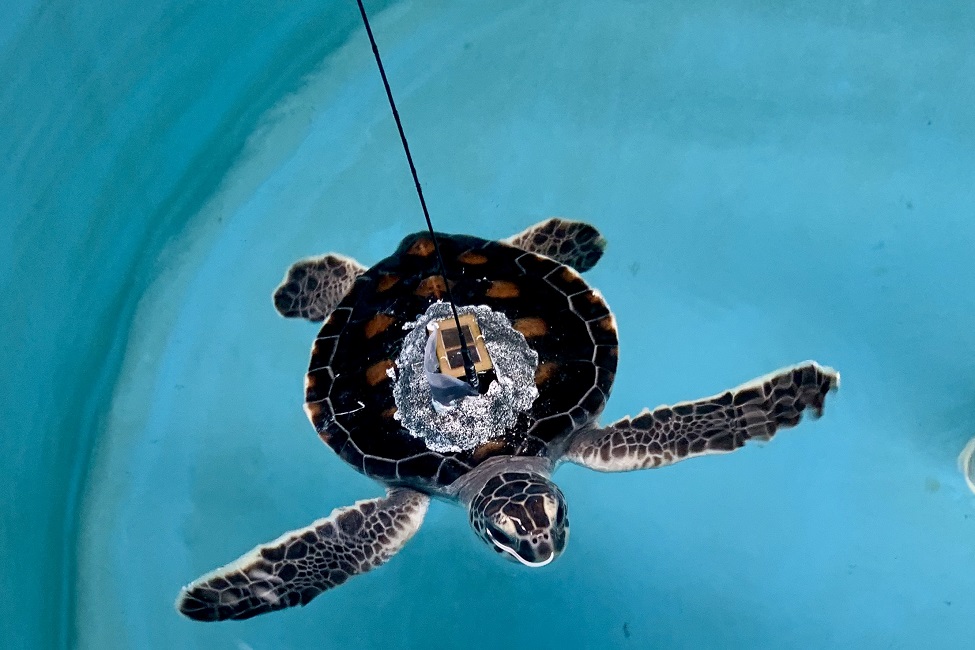FAU worked with members of the United States Coast Guard to provide the three female baby sea turtles with a special “seat” on board a 33-foot special law enforcement (SPC-LE) boat for their journey home. On March 27, they were released about 17 to 18 miles off shore in the Atlantic Ocean’s Gulf Stream Current.
The threatened green sea turtle (Chelonia mydas) named for the green color of the fat under its shell, normally travels to offshore waters as a hatchling and stays offshore for several years before going to the coastal reefs, estuaries, and around islands where it finds feeding areas with nutrient-rich algae and seagrass beds. Green sea turtles are different than loggerhead turtles because they are stronger swimmers and are more likely to burrow into sargassum, which is floating brown algae out on the high seas.
Green sea turtles are rarely observed in the open ocean and very little is known about where they go once they enter the sea as hatchlings to when they appear as large juveniles or adults in nearshore waters.
To keep tabs on the three green neonate sea turtles, the marine scientists outfitted them with small solar powered satellite transmitters, which is the smallest technology currently available for tracking marine turtles. Tracking the turtles, in collaboration with the University of Central Florida, Wyneken and her students hope to learn more about their offshore travels this season.
“This year, the ocean has remained exceptionally warm,” said Jeanette Wyneken, Ph.D., a professor of biological sciences in FAU’s Charles E. Schmidt College of Science, who worked with nine FAU directed independent study students and Emily Turla, a technician in her laboratory on the care and release of the hatchlings. “Among other things, warmer ocean temperatures may affect where these sea turtles’ offshore habitats are located. We are hoping to get a hint about the effects of warmer temperatures on their offshore behavior.”
Kate Mansfield, Ph.D., an associate professor of biological sciences at UCF, has programmed the satellite tags to transmit for about 10 hours, then shut down for 48 hours. She already has received notification of the whereabouts of the three green baby sea turtles.
“Our satellite tags are transmitting well and the turtles appear to be traveling in the Gulf Stream, on the edge of the Continental Shelf,” said Mansfield. “This track is similar to the immediate post-release tracks of all the other little green turtles that Jeanette and I have tracked as part of this same project.”
The three green sea turtles will be tracked for an average of about 60 to 70 days, after which the satellite tags will fall off. Data collected from the remote satellite trackers will enable Wyneken and Mansfield to answer questions about the early life travels of green sea turtles.
More immediately, Wyneken says that she is excited to engage her homebound marine biology students in where the turtles go when they leave the lab, as well as adding to the body of research on the impacts of climate change and warming temperatures on sea turtles.
– FAU –
About Florida Atlantic University: Florida Atlantic University, established in 1961, officially opened its doors in 1964 as the fifth public university in Florida. Today, the University, with an annual economic impact of $6.3 billion, serves more than 30,000 undergraduate and graduate students at sites throughout its six-county service region in southeast Florida. FAU’s world-class teaching and research faculty serves students through 10 colleges: the Dorothy F. Schmidt College of Arts and Letters, the College of Business, the College for Design and Social Inquiry, the College of Education, the College of Engineering and Computer Science, the Graduate College, the Harriet L. Wilkes Honors College, the Charles E. Schmidt College of Medicine, the Christine E. Lynn College of Nursing and the Charles E. Schmidt College of Science. FAU is ranked as a High Research Activity institution by the Carnegie Foundation for the Advancement of Teaching. The University is placing special focus on the rapid development of critical areas that form the basis of its strategic plan: Healthy aging, biotech, coastal and marine issues, neuroscience, regenerative medicine, informatics, lifespan and the environment. These areas provide opportunities for faculty and students to build upon FAU’s existing strengths in research and scholarship. For more information, visit fau.edu.
Original post https://alertarticles.info



